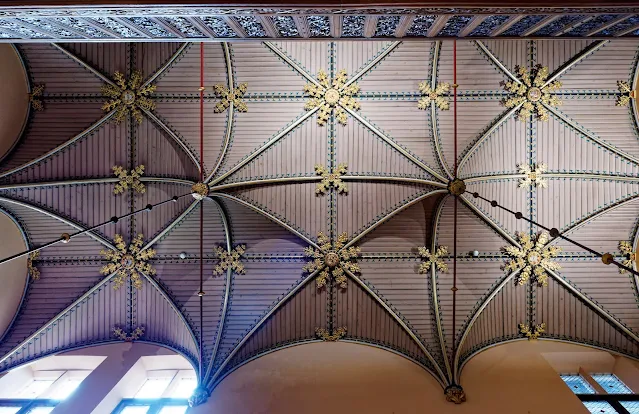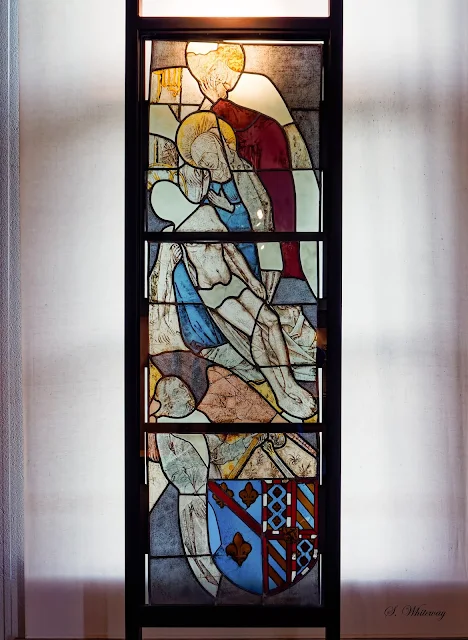 |
| Kasteel van Loopem |
Loppem Castle (Kasteel van Loppem) located just east of the town of Loppem, was built between 1858 and 1862 by Baron Charles van Caloen replacing an earlier 18th-century mansion. Architects Edward Welby Pugin and Jean-Baptiste de Béthune designed it with the latter giving it, its Flemish Gothic Revival appearance. The castle’s architecture, interior decoration, and furnishings were designed in the Flemish Neo-Gothic style and have been maintained in this style. This is unique as many Belgian castles (and honestly many castles worldwide) are often a mix of styles having been renovated by various architects and designers over the centuries.
The next couple of paragraphs are my Coles Notes version of Castle Loppem's place in Belgium history. I would hazard a guess that no castle is a stranger to political intrigue including Loppem Castle. In 1830, as a result of the Belgian Revolution, the area known as the United Kingdom of Netherlands was split up into three countries: The Netherlands, Belgium, and Luxembourg. A minor prince from the German House of Saxe-Coburg (boy did those Saxe-Coburg lads get around) was made King of Belgium in what was theoretically a constitutional monarchy. In reality, it was the king and a few oligarchs making all the rules.
 |
| Welcome to Castle Loppem! |
Fast forward to 1918, Loppem Castle had become the temporary home of King Albert I (October 24 - November 21). The king would have been considered by most standards a liberal. That coupled with the political climate of the day suggesting change was essential to maintain the peace and unity of the country; King Albert met with a group of socialist and liberal politicians at Castle Loppem. The result was the formation of a new government, numerous social reforms including trade union rights, and universal suffrage granted to men thereby breaking the hold of the oligarchy. This marked the beginning of modern Belgium. Of course, the oligarchs were a bit miffed. They noted that the procedures of the constitution had not been followed voicing complaints about what would become known as the “Loppem Coup”.
The interiors and furnishings were designed to complement and enhance the castle's architecture. The furnishings were designed by Pugin with the stained glass, chandeliers, staircases and fireplaces designed by Bethune. All were executed with amazing skill by local craftsmen. The interior touches contribute to the castle's authenticity and originality that reflects its design heritage while offering a glimpse into its past.
I would like to thank the staff of Loppem Castle and the Jean van Caloen foundation for gracefully answering all my questions. The quick and detailed responses were very much appreciated (
http://www.kasteelvanloppem.be/en).
Stained Glass Windows
Stain glass designed by Jean-Baptiste de Béthune and executed by locale artisans 1858-1862.
 |
| Small Family Chapel Stain Glass |
Staircases
The banister in the hall of the castle has 100 panels and each panel has a different design. The staircase was designed by Jean-Baptiste de Béthune and executed by locale artisans 1858-1862.
 |
| Bannister Panels with Hunting Theme |
 |
| Bannister Panel |
 |
Lion Newel Post Cap
(Lions are part of the van Caloen Coat of Arms) |
Castle Interiors
 |
Swooning of Mary
Antwerp Early 16th-century |
 |
The Bruges Burg Square
Anonymous, 17th century, oil on canvas |
 |
Saint Jerome in the desert, After P.P. Rubens
probably 17th century, oil on canvas |
The above painting is an old copy (smaller format) of the Saint Jerome of Peter Paul Rubens (ca. 1612-’15), kept in the Dresden Gemäldegalerie. Rubens portrayed the episode of Saint Jerome’s life as told in the epistle of Saint Eusebius and as popularised by the 13th century, Legenda Aurea. St. Jerome spent several years meditating in the Syrian desert. The traditional attributes of Jerome are portrayed; the skull symbolizing mortification, his books, and the lion whom he befriended by pulling a thorn from its paw.
The pose of the semi-naked, muscular male figure was inspired by a representation of St. Jerome by Titian, which Rubens had seen in Venice, and also by a statue known as the Dying Seneca (2nd century) in the Louvre, Paris.
Jean van Caloen, a grandson of Charles van Caloen, bought this well-crafted copy in 1913 from a Bruges antique dealer. Before that, the painting was in the possession of the family Depuydt in Poperinge.
 |
Time for a Nap, 17th century, oil on canvas
Gillis van Tilborgh (1625-1678), |
Gillis van Tilborgh (1625-1678), specialized in group portraits, paintings on the life of the lower class and elegant genre paintings. This painting has the monogram 'TB f(ecit)' which is how van Tilborgh signed his paintings. This painting is part of the van Ockerhout family legacy and was acquired as a result of the marriage of Albert van Caloen to Marie van Ockerhout.
 |
Saint Jerome (ca 1550)
copy of a painting by Joos van Cleve (ca 1485-1540) oil on canvas |
 |
Catharina Peussin
(Wife of Pieter Cassetta, alderman of the western district of the Franc of Bruges)
2nd quarter of the 17th century, oil on canvas |
 |
Portrait of Charles van Caloen
by Jean-Baptiste Anthony, autumn 1880, oil on panel |
This portrait is of 65-year-old Baron Charles van Caloen (1815-1896) in his senatorial costume. Charles van Caloen was a senator for the catholic party from 1867 until 1878. He commissioned the construction of the Loppem Castle, which is shown in the background. Anthony also painted a similar portrait of Charles's wife Savina de Gourcy Serainchamps.
 |
Portrait of Joseph van Caloen
by Flori Van Acker, 1922, oil on canvas |
Joseph van Caloen (1853-1932) was the oldest son of Charles van Caloen and Savina de Gourcy. In 1872 he entered the order of the Benedictines as 'dom Gérard'. He dedicated his life to missionary work. In 1893, the Pope charged him with the task of restoring the Benedictine order in Brazil. In 1906, he was appointed bishop in the mission area of the Rio Branco. In 1908 he became arch abbot of the Brazilian congregation. This portrait was painted by the well-known Bruges painter Florimond Van Acker (1858-1940), director of the Bruges art academy, a gifted painter of cityscapes, landscapes, genre scenes and portraits of notables and also an original designer of posters.
 |
The Lamentation of Christ
Antwerp Mannerism early 16th- century |
Antwerp Mannerism refers to an unidentified group of painters working primarily in Antwerp (but also in other Flemish cities) circa 1520 whose works bear certain characteristic features. Although attempts have been made to identify the individuals responsible for the several stylistic groups, most of the paintings remain attributed to anonymous masters. Characteristic of Antwerp Mannerism are works attributed to Jan de Beer, Jan van Dornicke, certain early paintings of Jan Gossart (1532) and Adriaen Ysenbrandt (1551). https://www.britannica.com/topic/Antwerp-Mannerists
 |
A view of the castle grounds.
For my fisher friends. |






















































